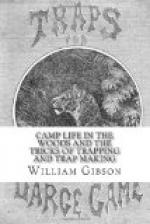is cut, with rounded ends, as seen in the illustration.
The bait stick should consist of a sapling about three
feet in length, the large end being trimmed so [Page
25] as to fit in the hole over the arrow while the
notch in the latter rests in the bottom of the aperture
as seen in the illustration (
b). The trap
may then be set. Draw back the arrow, until the
notch rests in the hole in the board. Insert the
bait stick
very lightly above the arrow as
shown at (
b), propping it in place at the angle
seen in the main drawing. The bait for a puma
should consist of a portion of some carcass, or if
for other animals, any of the baits given in our section
on “trapping” may be used. In order
to secure the bait firmly to the bait stick, a small
hole and a peg at the side of the baited end will
effectually prevent its removal and the trap win thus
most surely be sprung. The prop which sustains
the bait stick need be only a small crotch inserted
a little to one side of the trap. The bow should
now be surrounded by a wide pen, allowing room for
the spring of the ends. The top of the enclosure
should also be guarded by a few sticks or branches
laid across. Directly in front of the trap and
extending from it, a double row of rough stakes three
feet high should be constructed, thus insuring an
approach in the direct range of the arrow. Without
this precaution the bait might be approached from the
side, and the arrow pass beneath the head of the animal,
whereas on the other hand it is sure to take effect
in the neck or breast of its victim. Of course
the success of this trap depends entirely upon the
strength of the bow. When a large and powerful
one is used its effect is almost surely fatal.
Another form of the bow trap, much used in the capture
of the tiger, forms the subject of our next illustration:
no bait is here used. The trap is set at the
side of the beaten path of the tiger and is sprung
by the animal pressing against a string in passing.
The bow is large and powerful and is secured to two
upright posts about eight inches apart. The string
is drawn back and a blunt stick is then inserted between
the bow string and the inside centre of the bow, thus
holding the latter in a bent position. A stout
stick, with a flattened end is next inserted between
the end of the blunt stick and the inside of the bow,
the [Page 26] remaining part of the stick extending
downwards, as our illustration shows. To the
lower end of this stick a string is attached and carried
across the path in the direct range of the arrow, being
secured to a stake on the opposite side. The arrow
is generally barbed with a steel or flint point, and
wound with thread saturated with a deadly poison.
This is now rested on the top of the bow between the
upright parts, and its notch caught in the bow-string.
Everything is then in readiness. The tiger soon
steals along his beaten track. He comes nearer
and nearer the trap until at last his breast presses
the string. Twang, goes the bow and the arrow
is imbedded in the flesh of its victim. He writhes
for a few moments, until he is released from his torments
by the certain death which follows the course of the
poison through his veins.




